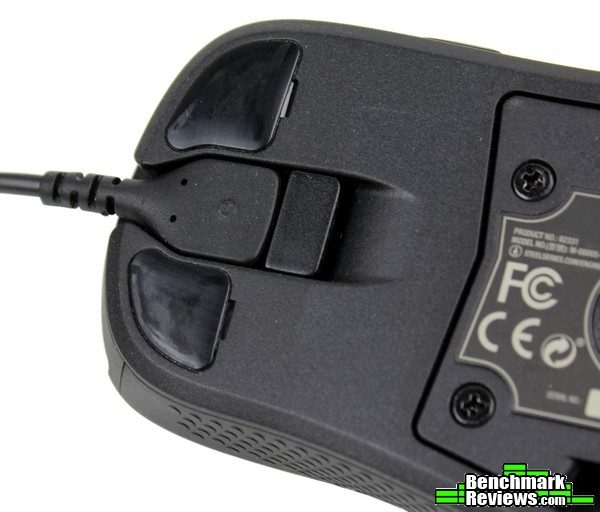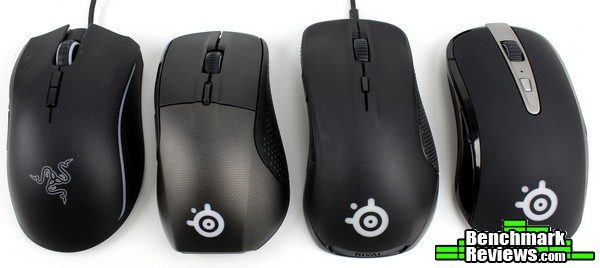PAGE INDEX
Comparison and Closer Look
Let’s get into some of the details that make the Rival 700 unique.

Four cross-tip screws secure the sensor module in place. The included PixArt 3360 optical sensor can be swapped for a PixArt 9800 laser sensor (purchased separately) if desired. I’m not sure how many users will take advantage of the modular nature of the sensor assembly, but the engineering is pretty well done. Modules are easy to install or replace, making it a near plug-and-play option for a different tracking feel.
 A slightly recessed locking mechanism keeps the detachable cable in place. There didn’t seem to be any extra drag associated with placing the connection at the bottom of the mouse instead of at the front, and the locking lever is easier to use in practice than some other “slide-to-unlock-cable” mechanisms on other mice.
A slightly recessed locking mechanism keeps the detachable cable in place. There didn’t seem to be any extra drag associated with placing the connection at the bottom of the mouse instead of at the front, and the locking lever is easier to use in practice than some other “slide-to-unlock-cable” mechanisms on other mice.

Placing the Rival 700 next to the original Rival is the best way to describe the evolution of the Rival line. The Rival 700 is a little more compact than the other Rival (original or 300), with slightly more angular lines tapering towards the rear and a more “cleaned up” shape overall. Handling both the original Rival and the Rival 700, the 700 definitely lends a more premium feel (the original Rival feels a bit lightweight / hollow in comparison to the more solid Rival 700).

The shape of the Rival 700 has progressed from its original dimensions as a DeathAdder clone as well (while the two were never identical, they were natural competitors in almost every aspect – button count, shape, tracking, price, etc.). While the pictured mouse from Razer is the Mamba TE instead of the DeathAdder, they use approximately the same shell. The Mamba TE and original Rival fill more of your palm when gripping the mouse, while the Rival 700 seems much more versatile to use switching between claw and palm grips.

The OLED screen is the remaining feature unique to the Rival 700. To be fair, SteelSeries has had more experience than most with the use of screens on mice; their Sensei laser mouse used a configurable LCD screen to display custom images and could even be used to navigate profiles and settings. That level of usability was exchanged for a high contrast OLED screen capable of displaying animations at 10fps and changing in real-time based on in-game events.

The default SteelSeries logo showcases a bit of a screen-burn issue with the OLED technology. It’s a little difficult to see due to the reduced file size of the image above, but setting the screen to all white still noticeably displays the SteelSeries logotype. This is mitigated somewhat as the OLED will turn off after about 20 seconds of inactivity, but this will only take place when not using the mouse at all – very few gaming sessions have periods of 20 sec+ downtime. Still, in the month I’ve been using the Rival 700 I haven’t noticed any other custom image “burned” into the display, so perhaps it’s just an effect that will fade over time. It is only noticeable in this very specific scenario, so it’s more something to be aware of rather than concerned about.

The Prism RGB LED system used by SteelSeries does a good job of displaying vibrant colors, from the typical red/green/blues to the trickier colors like yellow, teal and pink (even white is surprisingly neutral and free of tint). I especially appreciate how well the LEDs are diffused through the scroll wheel and palmrest logo, making the lighting effects look evenly lit and nicely blended.





Most Recent Comments